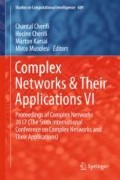Abstract
The present paper is devoted to the research into complexity of microblogging social networks regardless of their internal structure. This approach assumes using the results of nonlinear dynamical analysis of signals generated by the networks. The existence of the main indicators of social network complexity, such as scale invariance, tendency to unexpected and/or extraordinary events, non-equilibrium state and emergent properties, are shown using the example of Twitter. As a result, it is determined that the probability density function for a Twitter time series is a q-exponential (Tsallis) distribution and that the Kaulakys equation is the most adequate nonlinear random dynamical system for modeling of signals in social networks.
Access this chapter
Tax calculation will be finalised at checkout
Purchases are for personal use only
References
Mainzer, K.: Synergetics and complexity: emerging new science and civilization at the turn of the century. In: Complexity and Diversity, pp. 10–29. Springer, Heidelberg (1997)
Price, D.: Networks of scientific papers. Science 149, 510–515 (1965)
Barabasi, A.-L., Réka, A.: Emergence of scaling in random networks. Science 286, 509–512 (1999)
Albert, R., Barabasi, A.-L.: Statistical mechanics of complex networks. Rev. Mod. Phys. 74, 47 (2002)
Tadic, B., Mitrovic Dankulov, M., Melnikc, R.: Mechanisms of self-organized criticality in social processes of knowledge creation. Phys. Rev. E 96, 032307 (2017)
Tadic, B., Gligorijevic, V., Mitrovic, M., Suvakov, M.: Co-evolutionary mechanisms of emotional bursts in online social dynamics and networks. Entropy 15, 5084–5120 (2013)
Butts, C.T.: The complexity of social networks: theoretical and empirical findings. Soc. Netw. 23, 31–72 (2001)
Skvoretz, J.: Complexity theory and models for social networks. Complexity 8, 47–55 (2003)
Everett, M.G.: Role similarity and complexity in social networks. Soc. Netw. 7, 353–359 (1985)
Ebel, H., Davidsen, J., Bornholdt, S.: Dynamics of social networks. Complexity 8, 24–27 (2002)
Bocaletti, S., Latora, V., Moreno, Y., Hwang, D.-U.: Complex networks: structure and dynamics. Phys. Rep. 424, 175–308 (2006)
Dmitriev, A.V., Tsukanova, O.A., Maltseva, S.V. Investigation into the regular and chaotic states of microblogging networks as applied to social media monitoring. In: 13th IEEE International Conference on e-Business Engineering, pp. 293–298. IEEE Press (2016)
Prigogine, I., Lefever, R.: Theory of dissipative structure. In: Synergetics, pp. 124–135. Springer, Heidelberg (1973)
Hilborn, R.C.: Chaos and Nonlinear Dynamics: An Introduction for Scientists and Engineers. Oxford University Press, New York (2000)
Bak, P., Tang, C., Wiesenfeld, K.: Self-organized criticality: an explanation of 1/f-noise. Phys. Rev. Lett. 59, 381–384 (1987)
Bak, P., Tang, C., Wiesenfeld, K.: Self-organized criticality. Phys. Rev. A 38, 364–374 (1988)
Bak, P.: How Nature Works: The Science of Self-organized Criticality. Springer, New York (1996)
Mandelbrot, B.B.: Fractals and Chaos. Springer, New York (2004)
Grassberger, P., Procaccia, I.: Measuring the trangeness of strange attractors. Phys. D 9, 189–208 (1983)
Ding, M., Grebogi, C., Ott, E., Sauer, T., Yorke, J.: Estimating correlation dimension from a chaotic time series: when does plateau onset occur? Phys. D 69, 404–424 (1993)
Dubovikov, M.M., Starchenko, N.S., Dubovikov, M.S.: Dimension of the minimal cover and fractal analysis of time series. Phys. A 339, 591–608 (2004)
Mandelbrot, B.B., Ness, V.: Fractional brownian motions, fractional noises and aplica-tions. SIAM Rev. 10, 422–437 (1968)
Cambel, A.B.: Applied Chaos Theory: A Paradigm for Complexity. Academic Press, New York (1993)
Peters, E.E.: Chaos and Order in the Capital Markets. Willey, New York (1996)
Tsallis, C.: What are the numbers that experiments provide? Quim. Nova 17, 68–471 (1994)
Tsallis, C.: Nonadditive entropy and nonextensive statistical mechanics-an overview after 20 years. Braz. J. Phys. 39, 337–356 (2009)
Picoli, S., Mendes, R.S., Malacarne, L.C., Santos, R.P.B.: q-distributions in complex systems: a brief review. Braz. J. Phys. 39, 468–474 (2009)
Zhang, F., Shi, Y., Ng, H., Wang, R.: Tsallis statistics in reliability analysis: theory and methods. Eur. Phys. J. Plus 131, 379 (2016)
Kuznetsov, N.V., Leonov, G.A.: On stability by the first approximation for discrete systems. In: Proceedings of the International Conference on Physics and Control, pp. 596–599 (2005)
Arnold, L.: Random Dynamical Systems. Springer, Heidelberg (1998)
Kaulakys, B., Meskauskas, T.: Modeling 1/f noise. Phys. Rev. E 58, 7013–7019 (1998)
Ruseckas, J., Gontis, V., Kaulakys, B.: Nonextensive statistical mechanics distributions and dynamics of financial observables from the nonlinear stochastic differential equations. Adv. Complex Syst. 15, 1250073 (2012)
Ruseckas, J., Kaulakys, B.: Tsallis distributions and 1/f noise from nonlinear stochastic differential equations. Phys. Rev. E 84, 0511125 (2011)
Kaulakys, B., Alaburda, M., Gontis, V., Ruseckas, J.: Modeling long-memory processes by stochastic difference equations and superstatistical approach. Braz. J. Phys. 39, 453–456 (2009)
Kaulakys, B., Alaburda, M.: Modeling scaled processes and 1/f noise using nonlinear stochastic differential equations. J. Stat. Mech. Theor. Exper. P02051 (2009)
Tsallis, C.: Possible generalization of Boltzmann-Gibbs statistics. J. Stat. Phys. 52, 479–487 (1998)
Tsukanova, O.A., Vishnyakova, E.P., Maltseva, S.V.: Model-based monitoring and analysis of the network community dynamics in a textured state space. In: 16th IEEE Conference on Business Informatics. pp. 44–49. IEEE Press (2014)
Loskutov, A.Y.: Dynamical chaos: systems of classical mechanics. Phys. Uspekhi 177, 989–1015 (2007)
Loskutov, A.Y.: Fascination of chaos. Phys. Uspekhi 180, 1305–1329 (2010)
Acknowledgements
The work was supported by the Russian Foundation for Basic Research (grant 16-07-01027).
Author information
Authors and Affiliations
Corresponding author
Editor information
Editors and Affiliations
Rights and permissions
Copyright information
© 2018 Springer International Publishing AG
About this paper
Cite this paper
Dmitriev, A., Dmitriev, V., Tsukanova, O., Maltseva, S. (2018). A Nonlinear Dynamical Approach to the Interpretation of Microblogging Network Complexity. In: Cherifi, C., Cherifi, H., Karsai, M., Musolesi, M. (eds) Complex Networks & Their Applications VI. COMPLEX NETWORKS 2017. Studies in Computational Intelligence, vol 689. Springer, Cham. https://doi.org/10.1007/978-3-319-72150-7_32
Download citation
DOI: https://doi.org/10.1007/978-3-319-72150-7_32
Published:
Publisher Name: Springer, Cham
Print ISBN: 978-3-319-72149-1
Online ISBN: 978-3-319-72150-7
eBook Packages: EngineeringEngineering (R0)

